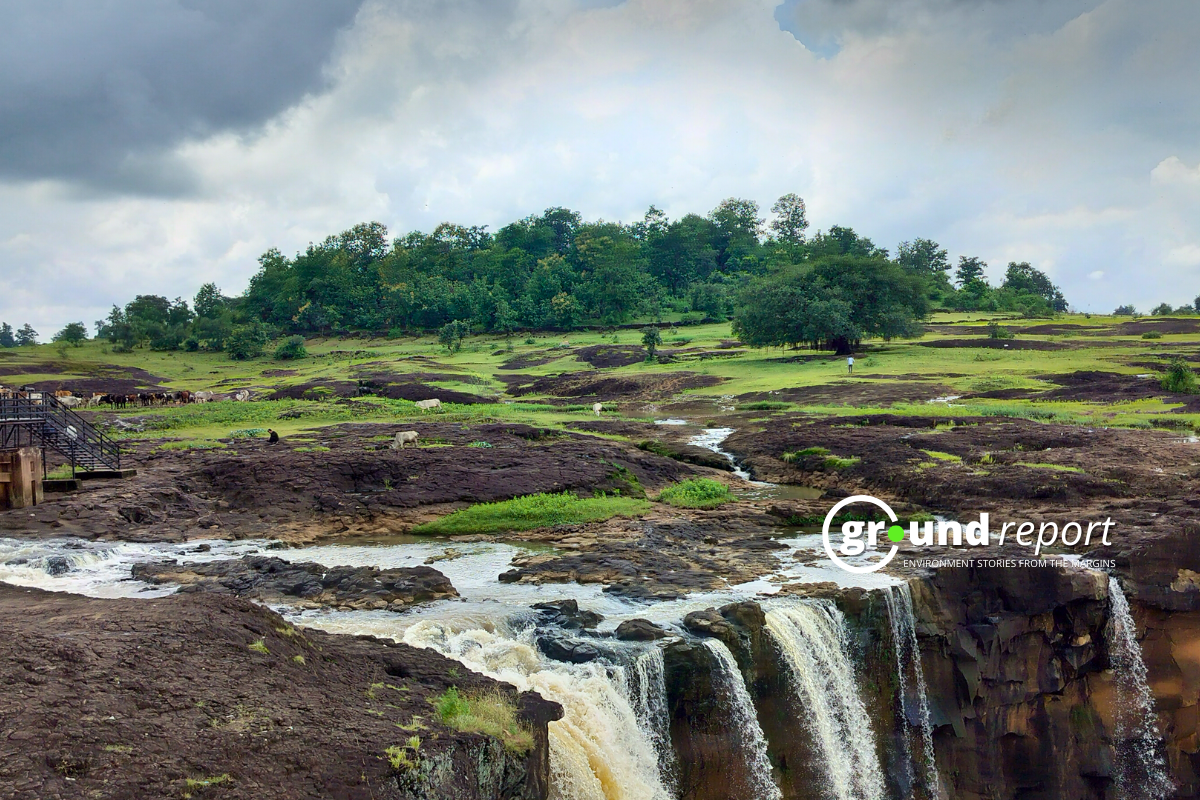In January 2020, Radhika Singh and Shail Joshi embarked on a 130-kilometer on-foot journey down the river Betwa, to understand the agrarian communities, practices around the riverine systems and their impacts on livelihood. As Sahil said, to have the ‘most incredible experiences… in a long time.’
Radhika works in water resource management in Nairobi, and Shail works as a senior program officer- at the World Wildlife Fund. They walked along the Betwa from Hamirpur to Orchha in the Bundelkhand region under the fellowship ‘Moving Upstream’ by the Veditum Foundation. Bundelkhand is a drought-prone region in Central India. Climate change over the years has made the situation worse. Radhika Singh and Shail Joshi authored the book Along the Betwa, documenting their experiences and insights.
“Communities are not homogenous… “was Radhika’s one of the central observations during the walk.
Siddharth Agarwal, founder of Veditum, while walking with journalist Paul Sadler-Peck from Punjab to Sunderbans, got inspired. Hence, ‘Moving Upstream’ became part of the Out of Eden Walk, a NatGeo-funded initiative by Paul Sadler-Peck.

The Ground Report spoke to Radhika Singh and Shail Joshi on their observations and experiences of understanding a river, and its ecosystem. Walking on foot in a region they were new to brought its challenges. They shared their observations on several socio-political, gender and environmental issues they noted on their journey.
Experiencing the world around Betwa
Radhika believes that this experience of walking along the river and seeing some of the challenges got her interested in how water resources could be sustainably managed in more arid places. [Secondly, about] the water insecurity issues due to excessive irrigation, as well as infrastructural projects that are sometimes not very well planned out by the government.
For them, the people were hospitable and though they were strangers, people let them come in, knocking on their doors and asking for food. They didn’t ask a single question, out of suspicion. Rather, they were curious about why we were doing this and things like that.
“Who gets to walk a river with absolutely no idea where you’re going to stay, where you’re going to eat food, or whether you’re going to have a roof on your head overnight?” Sahil said.

Recognising her privileged background and that she did not grow up in India, Radhika shared some funny moments where they could see that people just didn’t know what to make out of them. And, they had to explain themselves without sounding crazy about the reasons for their walk along the river.
Radhika said, “So, I think in those moments, there was just really this like, WOW! We just come from different universes.”
Towards the end of their walk after about a week, Sahil admits, it was a difficult journey. They were tired and could finally feel the happiness of their experience. Shail told us,
“In retrospect, it was one of the most amazing experiences we’ve had, I think.”
Betwa River, a river in northern India, rises in the Vindhya Range, North of Hoshangabad, Madhya Pradesh. It flows northeast through Madhya Pradesh and Uttar Pradesh states and joins into the Yamuna River, east of Hamirpur, after a 380-mile (610-km) course. Nearly half of its course, which is not navigable, runs over the Malwa Plateau before it breaks into the upland of Bundelkhand. Notably, the Betwa River will be linked with the Ken River under the river linking project in Madhya Pradesh. Latterly, the National Board for Wildlife (NBWL) has given its clearance for the Ken-Betwa inter-linking of rivers (ILR) project. Another noteworthy project on the Betwa River is the construction of the Matatila Dam, an undertaking between the states of Madhya Pradesh and Uttar Pradesh.
Diverse communities and caste-divide
Radhika observed that many of these villages had Swachh Bharat Abhiyaan campaigns. There were toilets and a lot of the villages were very clean. So, there were two things here. One was that some of the toilets were good, but they were on the periphery. Also, many Dalit villages didn’t have those toilets. So as usual, there was caste-based segregation in terms of the implementation of a national-level scheme.

But, at the same time, a lot of these villages were not clean. And Radhika noticed that it was because all the men kept loitering around. And once the men would, kind of, get up from their places, all the women would go clean. And that’s very telling of our society and how the social structures work, she observed. Things do become clean, but at what cost, Is this something that no one answers? The cost is women’s labour in this case, and for other reasons, it might be other people.
Sand mining, and related issues along the Betwa
Sand is the second-most-extracted resource on the planet after water. Sahil noted,
“We saw it [sand mining] happening at some places. But then, obviously, there were other issues we encountered while staying with people like, gender and livelihood. There were issues with agriculture as it relates to water systems. And there was another issue of outward migration to cities like Delhi, Mumbai and other places. So, that was largely the context that we were working in.”
As per Radhika, just the idea of how sand mining exists in people’s livelihoods across so many different scales. When they first started the walk, along the river, they saw just regular families, all mining sand from the riverbanks and just piling it into little triangles.
“Sand mining is perceived as exploitative, destroying ecosystems and rivers. But to label it as a criminal activity that the mafia is carrying out, I think, doesn’t do justice to all of the different ways in which people’s livelihoods depend on it. What Shail and I were interested in– as urban planners or regional planners– was this rural-urban connection, which often gets lost or forgotten, especially in cities.”
Shail believes, on the one hand, that the sand that they are mining is eroding the ecology and eventually having cascading impacts on their livelihoods. Be it agriculture or even land subsidence, they have to move further away because of floods. But they are the very same people who are digging the sand because they’re working as daily wage workers and labourers there. So, they’re digging their graves, but not by choice.
The Ken-Betwa River Linking Project
In Sahil’s opinion, for Betwa, the linking project was Nehru’s idea of doing this—linking all the rivers as the new modern India. Now it’s just being kind of repackaged and gift-wrapped, in a different way. The dam they want to build is within the Panna Tiger Reserve. Apart from hundreds and hundreds or thousands of trees being flattened, it’s going to impact livelihoods,, and more specifically, it’s going to impact biodiversity. It might not impact tigers, but it might impact the water sources that tigers rely on. This, in some ways, is a direct contradiction to “India’s tiger project” under which we are trying to increase the population of tigers. But, at the same time, we’re building dams in tiger reserves. Interestingly, both projects are national government-led projects.
The Ground Report has earlier reported on the Ken-Betwa River linking project.

Shail and Radhika keep on returning and have just constantly been reminded of the fact that communities are not homogenous. There is this idea of the community being a monolithic, homogenous thing. The way the government often engages with them doesn’t take into account the complexity. Government policies lack appreciation of how to deal with the diverse interests that a community would have. It’s the structural issue of how to transmit information from one place and get it registered in another place. And then have resources come back down to these people when it are needed. According to Radhika,
“It is an insane coordination, communication, and structural issue to deal with.”
In Radhika’s view on why different nations embark on these big infrastructure projects like dams, in the literature, it’s called the hydraulic mission. This is something that has been around for all of the 20th century, and it’s now in the 21st century. This link between techno-solutionism and water and the idea that water is something that can be controlled, harnessed, and used for livelihoods, for other purposes, has power. But the view of water itself, according to her, is ridiculous and disrespectful.
“I think everything that we’ve seen from the last 100 years shows how much we actually cannot control water and what it does in the long term. Like sure, we can [manage] for a decade, and we can for two decades, but when it comes to water, the best-laid plans will fail,” she said.
Lastly, when asked about what is lacking in addressing and reporting on the issues around rivers, Radhika, with her previous journalistic experience, says that it is important to move beyond the human interest, a personal story—whether it’s about an individual or a household—and that [the reports] victimise the person and the people. The reports portray situations as a little black-and-white. She thinks that is what they have tried not to do with their book. She said,
“What I think is important for journalists is to not necessarily pull on people’s heartstrings. But, really to present them [the reports] with a view of the world that presents a more nuanced and comprehensive view of what’s happening.”
Radhika and Shail’s experience widens the scope of understanding a river, not as merely a natural entity but as the personification of lives it carries forward with herself. It also opens the room for discourse on the different impacts of activities around a river on different communities based on their caste, gender, economic and social backgrounds.
The interview is edited for readability and comprehension.
Support us to keep independent environmental journalism alive in India.
Keep Reading
The costliest water from Narmada is putting a financial burden on Indore
Indore’s Ramsar site Sirpur has an STP constructed almost on the lake
Indore Reviving Historic Lakes to Combat Water Crisis, Hurdles Remain
Indore’s residential society saves Rs 5 lakh a month, through rainwater harvesting
Follow Ground Report on X, Instagram and Facebook for environmental and underreported stories from the margins. Give us feedback on our email id greport2018@gmail.com.
Don’t forget to Subscribe to our weekly newsletter, Join our community on WhatsApp, and Follow our YouTube Channel for video stories.








